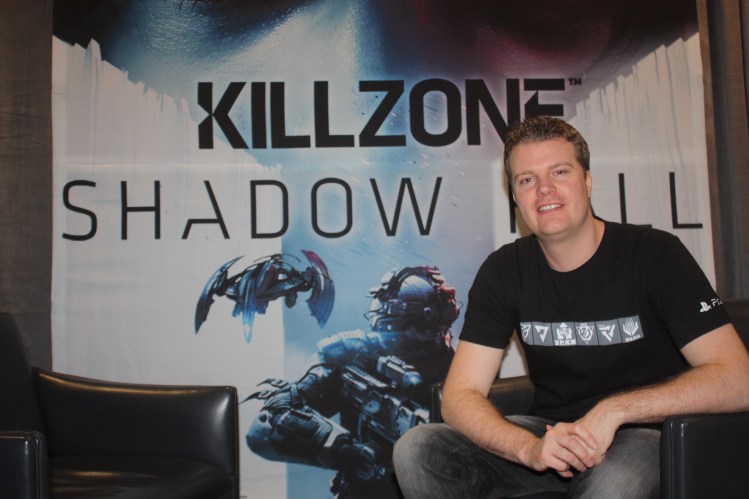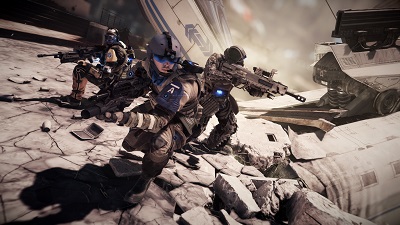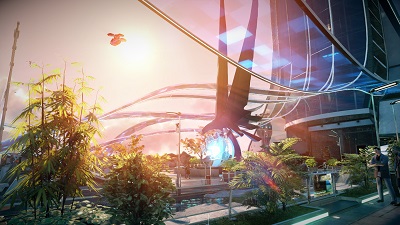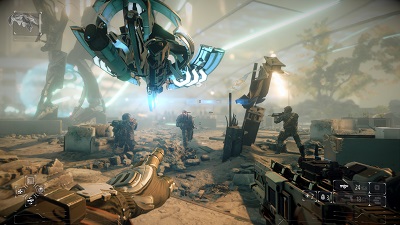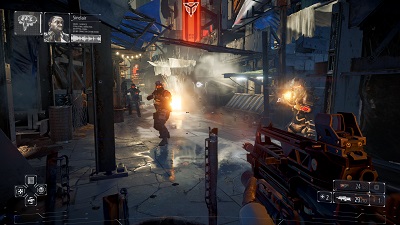Killzone: Shadow Fall is one of Sony’s big bets to woo gamers to the new PlayStation 4 home console this holiday season. The sci-fi shooter from Guerrilla Games is a launch title coming out (at the latest) on Nov. 15 when the PS4 launches in North America.
Shadow Fall takes place 30 years after the events of Killzone 3, and it features the continuing conflict between the Vektans and the Helghast, two rival colonist factions inhabiting a distant planet. In this scenario, both factions have been living side-by-side, separated by an enormous security wall, for three decades. But now their cold war is about to get hot, and we got the briefing on why from lead designer Eric Boltjes in an interview at Sony’s U.S. game headquarters in Foster City, Calif.
Among the twists in this game: You will be able to start out in multiplayer with access to all the weapons in the game. Life is too short for leveling up, Boltjes said.
Here’s an edited transcript of our interview.
GamesBeat: It seems pretty unusual to have so much available for you to shoot with at the beginning. You say that you’ve basically opened up everything in the multiplayer at the very beginning. Why did you take that approach?
Eric Boltjes: We want people to be able to pick up our game and instantly start playing how they want to play. For me, I’m more of a support type of player. I like to revive my friends. I’m not a very good shooter. I’m going to stay in the back. In a lot of games, you have to invest a lot of time in order to be able to play that way. We said, “No, we don’t want that. We want people to join, on day one or a year in, and play how they want.”
In single-player, it’s more structured, though. You’ll get more abilities as you play along and so on.
GamesBeat: In multiplayer, then, you’re earning different kinds of things. You’re meeting challenges and ranking up. What does that do to the multiplayer gameplay?
Boltjes: We start out with a level playing field, but what we wanted to do is allow people to become better at their playstyle. As you unlock challenges and so on, you do two things. One is that you kind of specialize. The guns are unlocked from the start, but when you complete new challenges, you get new scopes, you get new secondary fire options, things like that. You can tailor a weapon more toward how you want to play. The same goes for abilities. You can unlock improved versions of abilities. The core abilities are unlocked at the start, but you can get improved versions as you complete challenges.
On top of that, you get a lot of boosting material. Your rank goes up, but we also have something called your player card. Every time you kill someone, they see your player card. You can put stuff on there to brag – “I’m a support player, I’ve done a lot of support challenges.” I can make my player card announce that I’m a support specialist.
GamesBeat: Are you finding that people are choosing the most powerful weapons at first, ignoring anything that’s not as powerful?
Boltjes: We’ve spent a lot of time on creating a balanced spread of weapons. We’ve playtested — I don’t want to give a number. But it’s a lot. We’re a shooter, so the most important thing is weapon balance. We can never 100 percent guarantee that it’s fully balanced, because there are always people who figure out a way to exploit something. But the good news is, this time around, we can change weapon characteristics on the fly, without releasing a patch or anything like that. Postlaunch, if we see that there is an exploit, we can do two things. Either the community can turn off the weapon in their custom warzones, or we as a developers can tone it down on the fly. We’re going to look at the community, see how things develop, and react as we go.
GamesBeat: Allowing for those kinds of modded maps to be shown front and center, the custom warzones, is that something you’ve moved toward over time, or is that a significant departure?
Boltjes: We want to give power to the players. Rather than saying, as a developer, “Everybody go play this”—all different people want to play different things. Why should we limit them? That’s the power of what we’ve tried to achieve. We said, “Hey, build whatever you want. We’ll help you make it popular and find other people to play against.” It’ll be interesting to see how that pans out.
GamesBeat: You have a bit of a cold war theme in the story here. Have you worked in a lot of parallels to the historical Cold War?
Boltjes: We take inspiration from real-world events, yeah. Berlin had the Wall, for example. We have a city that’s divided by a wall. It’s an interesting part of history. I think it’s an important theme to look at. Who is the bad guy in this war? It’s always a gray area. Innocents always get hurt. I think it’s important to expose that in the game. It’s an interesting theme to work with.
GamesBeat: There’s a lot of spies and lone wolves making their way around this kind of war, then.
Boltjes: Correct, yeah. That’s part of the main core of the game. You yourself aren’t really a spy, but you’re a kind of intelligence soldier, a recon soldier. We call it a Shadow Marshal. You act in the shadows and perform deniable ops. But the enemy faction, the Helghast, have that as well. It’s a very different theme compared to what we’ve previously done.
GamesBeat: How much choice do you allow for in the single-player, as far as different branches in the story?
Boltjes: It’s still linear in the sense that you go from A to Z in the level. You have a primary objective and you complete it. But within that, there’s wiggle room. There are secondary objectives and optional objectives and things to explore. We always converge back to a bottleneck in the story, but before we do that, we give you a lot of room to figure things out yourself. You can determine the sequence of events before you go back to the main story.
GamesBeat: Do you still have the opportunity for the kind of big firefights you’ve had before?
Boltjes: Yes, definitely. As the story develops, let’s just say that the war does get a little hotter later on in the story. I can’t give too much away, but we do have larger battles. It gets really interesting as you develop through the story.
GamesBeat: A lot of people are very accustomed to shooters. How do you make sure it’s a fresh experience for those players who’ve played a lot of these games before?
Boltjes: Again, it comes back to player choice. We want to give players so many options during gameplay that they could play every encounter again, and if they use different options and different abilities each time, it could play out differently. If you see two people playing the same level, it will look different, because someone might be using shields and playing defensive, or they’re going on the offensive or maneuvering more. That keeps it fresh for us. Adding that kind of depth through abilities and giving the player more choice, that sets us apart.
GamesBeat: What are people going to notice about the PS4’s capabilities here?
Boltjes: Well, I hope people think it’s really beautiful. [Laughs] I’ll let them judge that for themselves. But it also allows us to create a more varied experience. For me, as a game designer, the PlayStation 4 has allowed me to put more enemy types, more objects, and more weapons into one specific encounter. That creates more variety, and that will shine through.
GamesBeat: Some designers have liked putting a lot of destruction into games lately. Is that something you’ve experimented with?
Boltjes: Definitely. One of the encounters you play here, all the walls are destructible. That gives you a way in to defended areas. Instead of going through the front door, where they’re waiting for you, you can blow through the wall and flank them. Again, it’s up to you.
GamesBeat: How did you reach this number of 24 players in multiplayer? Why is that optimal?
Boltjes: It’s not optimal in the sense that it works for every game. It really depends on what type of warzone you want to build. If you want to play a more tactical type of game, where people move slower and think about their actions, fewer players is better, and so we wanted to support that. You can play six on six or eight on eight. But some people like the really frantic, chaotic feel with more players to fight against, so we created the option for up to 24 players, 12 on 12. You’ll see, within the scope of all the different custom warzones, different numbers popping up and creating very different experiences.
VentureBeat's mission is to be a digital town square for technical decision-makers to gain knowledge about transformative enterprise technology and transact. Learn More
